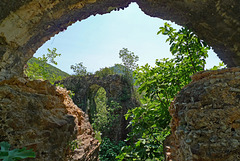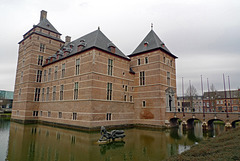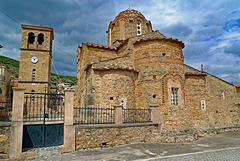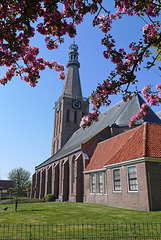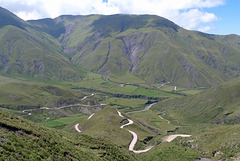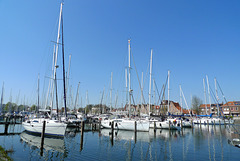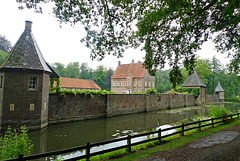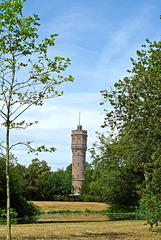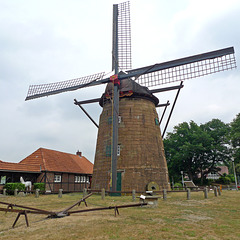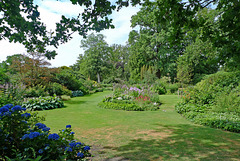Jaap van 't Veen's photos
Greece - Monument of Zalongo
| |
|
|
|
The Monument of Zalongo - placed in 1961 - commemorates the so called ‘Dance of Zalongo’, referring to a mass suicide of women and children in 1803 during the Souli War.
Ali Pasha, an Ottoman Albanian ruler who served as pasha of Epirus and the western parts of Thessaly and Greek Macedonia, wanted to finish once and for all with the Souliotes; the people of Souli who were creating problems for him and the Sultan. An agreement was signed, in which one part concerned the safe evacuation of women and children from Souli. But Ali Pasha failed to comply with the agreement and his troops attacked a group of Souliotes - among them women and children - in the mountains of Zalongo.
It is said that the Souli women came closer to the edge of a terrifying cliff. In order to avoid capture, enslavement and humiliation, the women held hands and started singing and dancing (Dance of Zalongo) and threw their children off that cliff and then they jumped to their death themselves one by one.
Despite the fact that some historians doubt wether there was an actual dance and song, the self-sacrifice of the Souli women in order not to fall in the hands of the Ottomans is indisputable.
The Monument of Zalongo - made by sculptor George Zongolopoulos - is visible several hundred meters high upon the edge of Mount Zalongo's cliff above Agios Dimitrios Monastery (PiP1). The monument depicts six abstract dancing female figures of the Souliot women. It is 18 meters long and 13 meters high. The figures are made of reinforced concrete, lined with about 4.300 limestone blocks, 40x30x25 cm. The construction took six years.
The Monument of Zalongo is accessible by climbing a rather steep stone paved path (PiP2) with more than 400 steps, which starts just behind the monastery. .
Argentina - Cachi, Iglesia de San José
| |
|
|
|
The Iglesia de San José (San José Church) was built in mid 18th century as a private religious place for the Aramburu family, the former owners of the lands where it is now located. Later they gave it to serve as a church to the town.
The church has a typical colonial architecture with adobe walls on a pebble foundation. It does not have a tower, but the three bells are located in the upper part of the façade. The church underwent an important modification in 1890, when a neoclassical portico was added.
Inside there is an extensive nave 35 meters long and two transverse chapels very close to the main altar. The altar features traditional decorations; an image of Christ on polychrome is the fundamental piece. Much of the elements (beams, altar, confessionals) are made of cactus-wood.
Iglesia de San José is located at the historical town square Plaza 9 de Julio with the white painted town hall. The church was declared a National Historic Monument in 1945.
Greece - Agios Georgios, Louros Aqueduct
| |
|
|
|
Near the village of Agios Georgios lies the Roman aqueduct over the river Louros. The aqueduct was built by thousands of slaves after 31 BC on the orders of Octavian Augustus - a Roman statesman and military leader and the first Emperor of the Roman Empire - who founded the city of Nikopolis or Nicopolis. (Recent researchers assign its construction during Hadrian’s rule, in the 2nd cent. A.D.)
The complete aqueduct carried potable water with the method of height difference from the springs of the river Louros in the mountains near Ioannina to two cisterns in Nikopolis over a distance of fifty kilometers, nearly the entire current region of Preveza. It consisted of a pipe, which was constructed in three ways: by carving a ditch, tunneling the area and constructing columns bridging the pipe over valleys. This ‘water pipeline’ is considered being one of the most important structures of the Roman period in northwestern Greece.
In the second half of the 5th century the aqueduct stopped functioning. From 1978 till 1980 the arches near Agios Georgios were restored. The aqueduct bridge over the Louros is one of the very few remaining in Greece today.
België - Turnhout, kasteel
| |
|
|
|
The beautifully restored Turnhout Castle, also known as Castle of the Dukes of Brabant ( Kasteel van de Hertogen van Brabant ) dates back to the 12th century. Originally it was the first hunting lodge of the first Duke of Brabant. In the 16th century the castle was rebuilt into a renaissance palace by Mary of Hungary, at that time the governors of the Netherlands and was used as a court of pleasure.
During the Eighty Years' War (1568-1648) Turnhout Castle lay on the front line. As a result it changed hands several times between the Spanish army and the Dutch rebels. In 1597 the north wing was burned down by the troops of Maurice of Nassau, Prince of Orange. After that the castle lost its military importance.
In 1702 Turnhout became a Prussian barony under Frederick the Great. In 1789, during the Brabant Revolution, the Austrians were driven out of Turnhout. They returned twice but in 1796 the castle was occupied by the French. They turned the castle into a court house and prison. The building was also used as a warehouse, a fire brigade and a weaving school.
In the 20th century the decayed castle was purchased by the province of Antwerp and was renovated in a classicist inspired neo-baroque style. The last renovation took place around the year 2000 and was opened again in May of that year.
At present Turnhout Castle - one of the most interesting buildings in the city - is used as a court of justice and is not open for visitors.
Argentina - Salta Cathedral
| |
|
|
|
The cathedral, located at the central square ( Plaza 9 de Julio ), is one of the most important and remarkable buildings of the city. The current church is the result of a couple of other constructions. The first one was a very simple building with adobe walls and a few windows. Due to its construction the church started to break quickly. A second church - now with two towers and a dome - was built on the same place and survived even an earthquake in 1692.
The current church started to be built in 1858 and it took twenty-five years before it was finished. The architectural style of the cathedral is neo-colonial. It has a rectangle floor - with beautiful tiles - and three naves, a presbytery and a semicircular apse in the high altar. The transept is very high, with a dome ceiling. The side aisles have stained glass windows.
The (pink coloured) cathedral is dedicated to Jesus and the Virgin Mary. In the year of 1941 it was declared a national monument.
Greece - Kalarrites, Kipina Monastery
| |
|
|
|
The Kipina Monastery - a couple of kilometers outside the village of Kalarrites - is considered being one of the most impressive monasteries in Greece. It is wedged into a vertical cliff and seems to be a part of the rock. It was constructed in 1212 and dedicated to the Assumption of Virgin Mary. A short path from the road leads to the monastery; after crossing a wooden drawbridge that guarded the entrance from invaders, one can take a look inside.
The katholikon inside a small natural cave is decorated with impressive frescoes, dating from the late 17th century/beginning 18th century. The iconostase is carved and gilded. During our visit it was absolutely dark inside the church and had to use my mobile-phone light for making some pictures. A secret door leads to a 250 meters deep cave, which was used to protect nearby residents.
During its existence the monastery played an important historic role, acting as both a secret school during the years of the Turkish occupation, as well as a hidden arsenal throughout the Greek War of Independence and the following liberation of Epirus.
The monastery got its name probably from the gardens ( kipoi in Greek) that were cultivated by the monks in the valley. Nowadays, there are no monks living in the monastery and it is free to visit. Just check if it is open, otherwise one has to collect a key from a nearby café.
Greece - Peloponnesus, Agios Nikolaos
| |
|
|
|
We did read about the stunning frescoes in the Byzantine Church of Agios Nikolaos -
4 km from Liotrivi - and wanted to visit them. First of all it was quite a job to find this small village, because it was not very well signposted.
After arriving in the picturesque village with just of couple old stone houses, we couldn’t miss the church with its beautiful architecture on the central square. Unfortunately the door of the church turned out to be closed. Although a couple of villagers tried to help, the door remained closed and we missed the frescoes.
Argentina - Los Cardones National Park
| |
|
|
|
Los Cardones is a national park in the province of Salta, between the city of Salta and Cachi. The park has an area of more than 65.000 hectares, with hills and ravines at elevations between 2.700 and 5.000 meters. This national park was created in 1996, when it was acquired by the park administration from private owners.
The national park got its name from the cardón (candelabra cactus or thistle), which is its dominant plant species. The column-like cactus plant has long been an important source of timber for rafters, doors, windows and more in the region. During its lifetime of 250 to 300 years the cactus can grow up to 12 meters.
From Salta the park is accessible through the wonderful Cuesta del Obispo
( www.ipernity.com/doc/294067/48959158 ); after passing Piedra del Molino the straight road called Recta del Tin-Tin crosses the park with cactus groves on both sides of the road.
Nederland - Kasteel Doorwerth
| |
|
|
|
Kasteel Doorwerth (Doorwerth Castle) is one of the oldest castles in the Netherlands with a history dating back to the 12th century. Historical documents mention the castle - probably wooden - as early as 1260. During that year it was besieged and burned to the ground. Twenty years later a second - stone - castle was also besieged and this time the bailey was burned down.
Since 1280, the castle has developed into a picturesque complex with a main castle and outbuildings, like the gate house, coachhouse and stables around the forecourt. Doorwerth Castle reached its largest form just after the middle of the 16th century under the 15th Lord of Dorenweerd ( Kasteel Doorwerth was known in earlier times as Kasteel Dorenweerd ; the present spelling of its name dates from around 1800). By 1560 the castle had more or less reached its current appearance.
When the castle was bought in 1837 by baron Van Brakell it was in a bad state (after it had been inhabited for many years) and restorations and modernization were necessary. But after the baron's death seven years later the castle again fell into neglect, which remained until 1910. It was bought by a retired artillery officer and again the castle was thoroughly restored, undoing some of the 19th century alterations and additions.
After 1913 it was used as a Dutch Artillery Museum. The medieval castle was seriously damaged at the end of the World War II (1944). A new extensive restoration took about 37 years, which brought the castle back into its 18th-century state .
Since the year of 1983 Ksteel Doorwerth and surrounding park are owned and managed by the Stichting Geldersch Landschap en Geldersche Kasteelen , a Dutch heritage foundation; castle and park are open for visitors.
Nederland - Medemblik, Bonifaciuskerk
| |
|
|
|
The construction of the Bonifaciuskerk (Boniface Church) started in 1404 and was completed in the 15th century. In the year of 1517 the city was attacked and burnt; the church was also destroyed, however the tower remained undamaged. After re reconstruction city and church were burnt to the ground and again the tower was spared.
The rebuilding started again in 1555 in the same form as the current church. The church is a late-gothic hall church with three aisles.
The tower - hundred years older than the church - got its present crowning in 1661. It has three bells, the oldest and largest has a diameter of 1,25 metres. The tower of the church is leaning, which is possibly caused by the reclamation of the Wieringermeer (a polder near Medemblik). Over the past 30 years, it has subsided by an average of 3 mm per year.
Originally Sint Maarten (Saint Martin) was the second church patron, next to Sint Bonifacius (Saint Boniface). After the Reformation in 1572 the name of Bonifacius remained with the Reformed church and Sint Maarten became the principle patron of the Roman Catholic church in Medemblik.
Argentina - Cuesta del Obispo
| |
|
|
|
The Cuesta del Obispo (Bishop’s Slope) is a winding and steep stretch of Ruta33, located between the hamlet San Martin in the Escoipe Valley and the Piedra del Molino (PiP5) in the province of Salta. During more than 20 km the dirt road winds its way up with many hairpins to the highest point of the road - 3.348 meters above sea level - between Salta and Cachi. A grinding stoned, carved in granite gives the name to that place: Mill Stone.
The slope was called Cuesta de la dormida del Obispo (Slope of the sleeping bishop), because in 1622 the bishop of the diocese of Tucumán traveled from the city of Salta to Cachi and had to spend the night uncomfortably in the middle of the slope. Later and with time the name was simplified to as it is known today: Cuesta del Obispo .
(We did drive this road - which was quite an adventure - and were quite lucky with the dry weather. When it rains the road is often blocked for regular cars. We came across a couple of gauchos (PiP3) with their horses and made several stops, enjoying the fascinating landscape with grassland. One of them was a viewpoint towards Valle Encantado (PiP2).
Nederland - Medemblik, Pekelharinghaven
| |
|
|
|
As early as 1289, Medemblik received its city rights and the end of the 16th century it has its own harbours. Four of them are located near the city centre. The Pekelharinghaven (Salt Herring harbour) is the largest and is situated adjacent to the Radboud Castle ( www.ipernity.com/doc/294067/48611904 ).
The name refers to the old harbour that was in use during the 17th and 18th centuries. After the harbour had silted up, the location was used as a sports field for many years. Until 1988 when the construction of a new marina was started, which was inaugurated in 1989. Nowadays the harbour has a total of 220 berths for yachts up to 15 meters.
Germany - Ochtrup, Haus Welbergen
| |
|
|
|
Haus Welbergen (Welbergen Castle) is most probably one of the most beautiful hidden gems of Münsterland. Although the moated castle is not as well known as many other castles in Westphalia, it is in no way inferior to them in terms of beauty and charm.
A Gräftenhof - a farmhouse surrounded by an articially moat - is already mentioned in 1282, on the spot where now Haus Welbergen stands. The "Herren von Welleberghe" lived on the estate from 1298 to 1330. In the middle of the 16th century it was converted into a moated castle; the moat is fed by the Gauxbach.
In the eighteenth century the current size and style has been given shape. Haus Welbergen is built mainly of bricks and has sandstone window frames.
After crossing a drawbridge one arrives on the forecourt, which is bordered by the gatehouse, farm buildings and stables on one side and by a wall with round corner turrets and a little chapel on the other side. In the middle of the inner courtyard of the castle is a small but very interesting garden.
There have been several changes of ownership over the centuries until the more or less dilapidated castle was bought in 1929 by Dutch banker Jan Jordaan and his wife Bertha Jordaan - van Heek (daughter of well known Dutch textile entrepreneur Gerrit Jan van Heek). After the death of Bertha in 1960, the total possession of Haus Welbergen has been brought in a foundation: the Bertha Jordaan-van Heek stichting , with the purpose to maintain the entire property and the artistic exchange between Germany and the Netherlands.
Nowadays Haus Welbergen is used for meetings and gatherings. The house and the art collection can be visited by groups and appointment. Public areas such as the forecourt, gardens and the park are open to the public.
Argentina - Purmamarca
| |
|
|
|
Purmamarca is a rather small village, located in the Quebrada de Humahuaca (a UNESCO world heritage site), yet it is one of the most popular travel destinations in Argentina. It sits next to the Cerro de los Siete Colores (PiP1), the most famous landmark in Northwest Argentina.
This breathtaking Hill of the Seven Colours (more than 2.300 meters above sea level) is composed of seven different colours, all of which derive from different types of rocks. Each colour/rock is also said to have formed during different time periods. Its estimated age goes back for million years.
The heart of picturesque Purmamarca - with its adobe houses and unpaved streets (PiP4) - is Plaza 9 de Julio . The square offers a daily market (PiP2 and 3) and is completely filled with artisan stalls, selling all kinds of handicrafts like tapestries, hand-knitted clothing, artwork, sculptures, pottery, etc. The square is surrounded by small local shops, cafes and restaurants.
Purmamarca means 'desert village' in the local Aymara language.
Nederland - Delden, watertoren
| |
|
|
|
The water tower in Delden - designed by architect H.P.N. Halbertsma - was built in 1894 and belongs to the Twickel Estate ( www.ipernity.com/doc/294067/48898228 ). The construction of the tower was commisioned by the owner of Twickel Baron Heeckeren of Wassenaer. The water tower is made of red brick in a neo-Renaissance style. The tower has the status of a Dutch national monument.
Originally the tower was intended to serve as a water reservoir for extinguishing fires on Twickel. When the tower was put into use it also served as a water supply system for the village of Delden. When it turned out that the water contained much salt and could not be used as drinking water, the tower was connected to the water supply system of the nearby city of Almelo. For this purpose, a pipeline of more than 10 kilometers had to be constructed. The salt was derived from a salt layer in the bottom of Delden. This salt layer is later commercially exploited (nowadays Delden has even a salt museum).
The water tower has a height of 37.50 meters - which make it a well known landmark of Delden - and a water reservoir of 200 m³. The tower is still used as a ‘storage vessel’ ensuring drinkwater comes under enough pressure to the citizens of Delden.
Germany - Gildehaus, Ostmühle
| |
|
|
|
The Ostmühle (East Mill) on the Mühlenberg (100 meter above sea level) in Gildehaus is a Dutch tower mill. The mill was built in 1749/1750 from Bentheim sandstone and has a long and turbulent history. Three year before a violent storm destroyed a wooden mill on the same spot. The mill was privately owned from 1913 to 1986. It was in danger of being demolished several times.
The mill has been in operation again since 1986 and is managed and maintained by the tourist information Gildehaus. In the year 2011 an extensive renovation took place. When there is enough wind, hobby millers will make crispy bread from the freshly milled grain in the adjacent bakery. Mill and bakery are now a museum and can be visited, but has limited opening hours (during our vist it was closed).
Argentina - Perito Moreno Glacier
| |
|
|
|
The Perito Moreno Glacier (Glaciar Perito Moreno) was formed during the last ice age, which means it is about 18.000 years old. The glacier is located within the Los Glaciares National Park and is one of the 48 glaciers of the Southern Patagonian Ice Field, the world’s third largest reserve of fresh water. Perito Moreno ends in a fjord, where the ice is up to 60 or 70 metres above the level of Lago Argentino (two-thirds are still below the water level and cannot be seen) and it is 5 km wide.
Despite climate change Perito Moreno is one of the few glaciers in the world that still grows, one or two metres a day. From time to time the glacier’s front ice tongue moves forward and joins the shore of Peninsula de Magallanes, creating a massive ice dam. This natural dam makes a part of Lago Argentino raise its level, causing a huge amount of pressure. Finally - this can takes some years - the water pressure is getting too high and the enormous wall of ice falls apart, causing one of the most overwhelming natural phenomenon that can be seen.
(It happened just a couple of months after our visit in 2005. The last rupture of Perito Moreno was in March 2018. You even can see the difference between the water level of the two parts of the lake.)
The glacier is named after Francisco Moreno, an Argentinean explorer who explored this area in the 19th century and managed to keep it out of Chilean hands. The Los Glaciares National Park, of which Perito Moreno Glacier is a part, was declared a UNESCO World Heritage site in 1981.
The glacier is accessible from El Calafate in Patagonia. Peninsula de Magallanes has several platforms, which make it possible to get close to the glacier. It is also possible to sail along the glacier by boat.
Nederland - Delden, Twickel Kasteel tuin en park
| |
|
|
|
Twickel Castle ( www.ipernity.com/doc/294067/48898228 ) is well-known for its garden and park. The landscaping of the gardens has been created over many generations and gives an impression of the history of the garden since the renaissance.
Next to the castle there is a garden in the French neo-baroque style (PiP1) with clipped figures of the taxus and buxus trees. The historical orangery (PiP1) dates, in its current form, to the first half of the 19th century and serves as a winter shelter for many tropical and subtropical plants, including some 300-year-old orange trees. The so called 'rock garden' (main picture and PiP2) in Victorian style has been designed by Baroness van Heeckeren Van Wassenaer.
The surrounding park, with its large water gardens (PiP3), was developed in English landscape style during the 18th and 19th century. The park has also a wildlife sanctuary (PiP4) with a pack of fallow deer.
Jump to top
- ipernity © 2007-2024
- Help & Contact
|
Club news
|
About ipernity
|
History |
ipernity Club & Prices |
Guide of good conduct
Donate | Group guidelines | Privacy policy | Terms of use | Statutes | In memoria -
Facebook
Twitter



